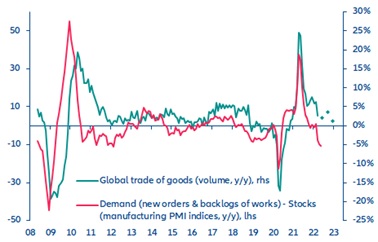- A contraction in global trade in Q2 2022…With the omicron crisis in China prolonging supply-chain bottlenecks and bringing port congestions back to the worst levels seen in 2021, global trade of goods in volume terms should decline by -1.3% q/q. Overall, we now forecast global trade to grow by +3.5% in 2022 in volume terms, down from our previous forecast of +4.0% (and much below consensus ranging between +4.5% and +5.0%). In value terms, global trade is now set to grow by +10.4% in 2022, with the trade price component more than three times higher than what we expected before the war in Ukraine and the lockdowns in China.
- …But China’s mild reopening will help the trade recovery. Global trade should grow by +1.1 q/q in Q3 2022 and +0.8% in Q4. Barring renewed large waves of Covid-19 infections, we expect stringency at the national level in China to normalize in July – even if the zero-Covid policy remains a risk. This means that industrial activity should recover mildly, and manufacturers dependent on Chinese goods could experience some relief in the fall as it will take two to three months for port congestion to normalize.
- Improving supply from China would bring the largest production boost to the agrifood, pharma and software & IT services sectors in Europe and the US. Using our proprietary database to map out global production chains that involve Chinese suppliers, we estimate an increase by over +5% for each sector in the second half of the year compared to last year’s levels. This boost in output should be sold or stocked, the latter helping to reinforce the inventory buffer against potential future shocks (e.g. if the zero-Covid policy is maintained throughout 2022 in China).
- Among major Western economies, Germany could see the largest GDP boost thanks to the improved access to inputs from China. Our analysis of importing countries, supply-chain links and the sectoral breakdown of value added reveals that the Chinese reopening could help German GDP grow by up to an extra 0.5% in 2022 – all else being equal and assuming that the activity boost fully materializes in additional output through consumption or inventory. In France and the UK, the benefit to GDP would reach up to 0.3%, as their share of the manufacturing sector is lower.
China
A trade recession before a mild Chinese reopening?
Advanced indicators confirm our forecast for a global trade recession in Q2, partly driven by China’s lockdowns.
Global trade in volume terms contracted in Q3 2021 and after the start of the war in Ukraine, we pointed out that the risk of double-dip in global trade in H1 2022 had increased – not only due to supply-chain bottlenecks, but also because of lower demand (also see report here). The omicron crisis in China led us to confirm this expectation (See our report on the cost of zero-Covid policy for China and the World). These consecutive shocks to the global economy have led to an acute mismatch in the global balances of demand and manufacturers’ inventories. In sequential terms, we now expect global trade of goods in volume terms to contract by -1.3% q/q in Q2 2022, followed by a mild recovery in the rest of the year (+1.1% q/q in Q3 and +0.8% in Q4).
Overall, global trade is set to grow by +3.5% in 2022 in volume terms, down from our previous forecast of +4.0%. Indeed, this new number takes into account the full extent of China’s omicron crisis, which is now largely past but lasted longer than previously expected. The slower Chinese economy is creating an exports shortfall for the rest of the world that is estimated at USD160bn. This comes on top of to the shortfalls triggered by the direct and indirect effects from the war in Ukraine (USD480bn). In total, close to 2% of global trade is at risk of being lost in 2022. As a result, risks remained skewed on the downside. In value terms, global trade is set to grow by +10.4% in 2022 as the price effect from supply-chain bottlenecks and transportation congestions remains high.

Contact
Allianz Trade
Allianz Trade